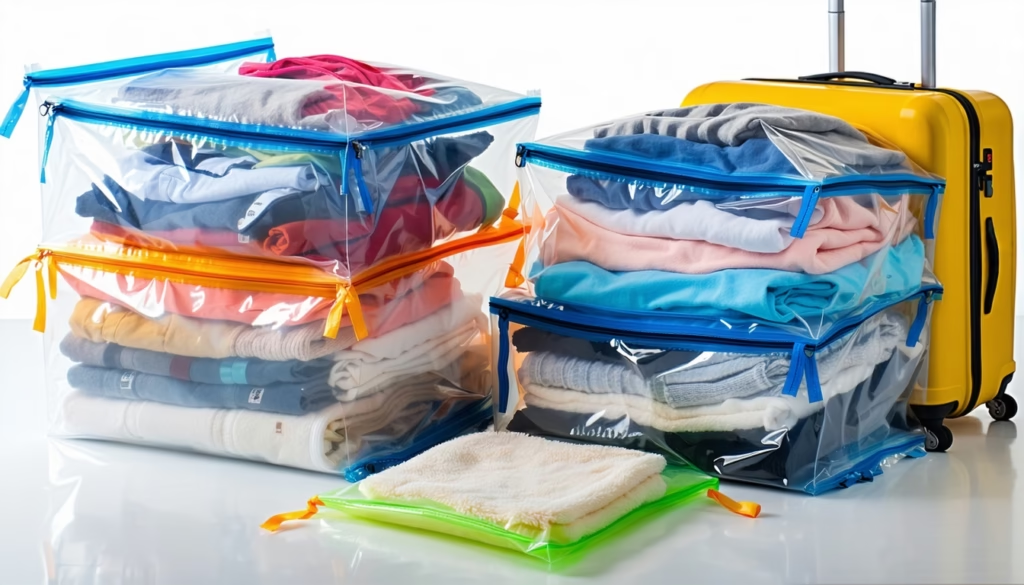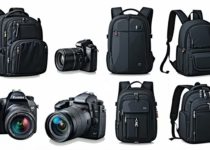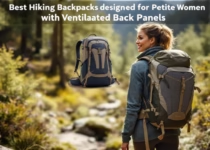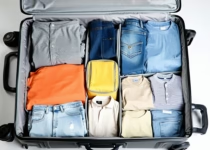Best Vacuum-Sealed Bags For Packing Bulky Clothes

Packing bulky clothes into your backpack can feel like a puzzle, especially when you’re eyeing every inch of space. When it comes to finding the best vacuum-sealed bags for packing bulky clothes, you want something reliable, simple to use, and tough enough for repeated trips. These compression bags can shrink your jacket, sweaters, and bedding by up to 80 percent, so you can tuck them neatly under your gear. In this review, you’ll find the top vacuum bags, a breakdown of must-have features, size tips, and smart packing hacks so you can fit more into your backpack with ease.
If you’re new to vacuum bags or want a quick walkthrough, check out our How to Use Vacuum Bags for Efficient Space-Saving Packing (/how-to-use-vacuum-bags-for-efficient-space-saving-packing). By the end, you’ll know exactly which set to grab for your next adventure.
Review Top Vacuum Bags
Gongshi Vacuum Storage Bags
These versatile vacuum bags compress bulky sweaters and coats down to about 25 percent of their original volume. You get a pack of 12 in assorted sizes, so you can mix and match for different items. The triple-seal turbo valves lock out air, and the thick plastic walls block dust, moisture, and pests.
Pros
- Compresses up to 75 percent, saving serious space
- Durable, five-layer plastic protects against tears
- Includes extra-large and medium bags for varied needs
Cons
- Hand pump sold separately
- Bags may slide if stacked without support
MagicBag Vacuum Storage Cubes
MagicBag cubes shine when you need to pack bedding or off-season layers. Their square design fits neatly into backpack compartments or under your gear. You’ll see about a 45 percent reduction in volume, and the included hand pump makes it easy to evacuate air.
Pros
- Ideal for thick comforters and jackets
- Simple valve design for quick seal
- Clear panels let you spot contents at a glance
Cons
- Fewer bags in the set (4 total)
- Slight bulge on very thick items
Vacwel XXL Vacuum Storage Bags
If you deal with oversized jackets or bulky comforters, Vacwel’s jumbo bags are lifesavers. They squeeze volume down by around 70 percent and hold compression over time. The set comes with five extra-large bags that tuck under your pack without weighing you down.
Pros
- Giant size fits large gear
- Reliable seal keeps air out for weeks
- Sticker labels help you stay organized
Cons
- Bulky when empty
- Requires careful folding to avoid creases
Spacesaver Vacuum Storage Bags
Spacesaver bags earn top marks for ease of use. You’ll find nine bags in different sizes, each with an intuitive valve and a hand pump that clips on easily. Even if you’re new to vacuum packing, you’ll be done in minutes.
Pros
- Fast pumping action
- Color-coded sizes for quick sorting
- Textured surface prevents sliding
Cons
- Pump handle can feel flimsy
- Some bags lose slight compression over months
Taili Hanging Vacuum Storage Bags
Taili’s hanging bags let you keep packed suits, dresses, and coats on a closet rod until it’s time to travel. They reduce garment volume by around 80 percent and maintain a smooth shape thanks to their curved design. These are perfect if you want wrinkle-free packing and easy closet access.
Pros
- Built-in hanger rod
- Strong seal for long trips
- Clear construction shows contents
Cons
- Zipper can be stiff
- Curved shape limits stacking
Flextail Vacuum Storage Bags
Flextail’s heavy-duty bags compress up to 75 percent of original volume, and you can pair them with an optional electric pump ($32) for minimal effort. Their thick, flexible plastic stands up to repeated use, and the wide valve accepts most household vacuums.
Pros
- Excellent compression rate
- Optional electric pump speeds the process
- Durable, multi-use construction
Cons
- Electric pump sold separately
- Bags are bulkier when not in use
Assess Key Features
Material And Durability
You want bags that resist punctures and stand up to rough handling. Look for multi-layer plastic, ideally five layers thick, so your items stay sealed and safe from dust, moisture, and pests. Thicker walls also reduce the risk of bag failure when you’re hiking or shifting gear.
Compression Efficiency
Not all vacuum bags squeeze down equally. Some trim volume by 45 percent, while others hit 80 percent reduction. Think about what you’ll pack—lighter garments handle more force, but delicate fabrics may need a gentler squeeze. Aim for at least a 70 percent reduction if backpack real estate is tight.
Valve And Pump Design
A well-designed valve makes all the difference in a fast seal. Turbo valves that lock in air are ideal, as are wide fittings that work with both manual and electric pumps. If you have access to a standard vacuum, double-check that the valve size fits your hose.
Visibility And Organization
Clear plastic lets you spot what’s inside without unsealing. Some sets include sticker labels or color-coded edges, so you can keep sweaters in one bag and jackets in another. That saves precious minutes when you need to switch outfits on the go.
Choose The Right Size
Match Bag Size To Items
Small bags (around 6 x 10 inches) work for socks, underwear, or rolled tees. Medium bags (11 x 16 inches) suit shirts and lighter sweaters. Extra-large options (26 x 34 inches) handle comforters, winter coats, or multiple bulky pieces at once. Pick a set that offers the right mix so you’re not wasting space on half-empty bags.
Consider Backpack Dimensions
Measure your backpack’s main compartment before you shop. You don’t want bags so wide they bunch up against zippers or straps. If your pack has sleeve pockets, slim, tall bags might slide in neatly. Always test one empty bag to check fit before filling and sealing.
Maximize Backpack Space
Combine With Packing Cubes
Vacuum bags shine when paired with packing cubes, so you can group similar items before compression. For step-by-step tips on combining these tools, see how to use packing cubes for ultimate luggage organization(/how-to-use-packing-cubes-for-ultimate-luggage-organization). Cubes help you sort gear, then vacuum bags shrink it down further.
Layer Clothes Efficiently
After vacuum packing, layer your heaviest items at the bottom of your backpack and lighter vacuum bags on top. That keeps your pack balanced and makes each compression bag easy to slide in. For a complete walkthrough, check our step-by-step guide to layering clothes efficiently when packing(/step-by-step-guide-to-layering-clothes-efficiently-when-packing).
Separate Clean And Dirty
Keep fresh and worn items separate by designating a vacuum bag for dirty laundry. It locks odors in and saves you from mixing garments in backpack crevices. You can also use color-coded bags or add a sticker to spare your brain on busy travel days—see best ways to separate clean and dirty clothes when traveling(/best-ways-to-separate-clean-and-dirty-clothes-when-traveling).
Pack Smart For Your Trip
Ever tried stuffing winter gear into a daypack? Vacuum bags tackle that challenge head on. If you need more space-saving hacks, our genius packing tricks for fitting everything in a backpack(/genius-packing-tricks-for-fitting-everything-in-a-backpack) will give you bonus ideas for light yet thorough packing.
Frequently Asked Questions
Can Vacuum-Sealed Bags Damage Delicate Fabrics?
Vacuum pressure can crush delicate fabrics like lace or silk, so avoid sealing those items for long periods. Instead, use medium compression or store them separately using breathable garment bags.
How Long Can I Store Clothes In Vacuum Bags?
You can safely store clothes for up to six months, but avoid leaving natural fibers like wool or leather under constant pressure. For long-term storage, check bags periodically for creases or moisture.
Will Vacuum Bags Work In A Carry-On Packed Backpack?
Yes, vacuum bags shrink bulky items enough to slip into a carry-on backpack section, but confirm dimensions first. Slim bags slide into laptop sleeves or front pockets when folded correctly.
How Do I Prevent Moisture Buildup Inside Vacuum Bags?
Ensure items are clean and fully dry before sealing. You can add a small silica gel packet inside the bag to absorb any stray humidity that tries to sneak in.
Can I Reuse Vacuum-Sealed Bags?
Most high-quality vacuum bags are designed for multiple uses as long as you handle them with care. Avoid sharp edges and follow cleaning instructions to maintain the seal.
Do Vacuum Bags Count Toward Airline Weight Limits?
Yes, vacuum bags count the same as any packed item, so weigh your backpack before you head to the airport. Their space-saving benefit won’t reduce overall baggage weight.
Conclusion And Recommendations
Vacuum-sealed bags are one of the simplest ways to free up backpack real estate, letting you carry more gear without extra weight. For all-around performance, Gongshi Vacuum Storage Bags deliver consistent compression and lasting durability. If you need jumbo capacity, Vacwel XXL Vacuum Storage Bags tackle oversized comforters and heavy coats. And if quick, user-friendly packing is your top priority, Spacesaver Vacuum Storage Bags fit the bill.
Try one of these top picks on your next trip, and you’ll wonder how you ever packed without vacuum compression. Safe travels and happy packing!


